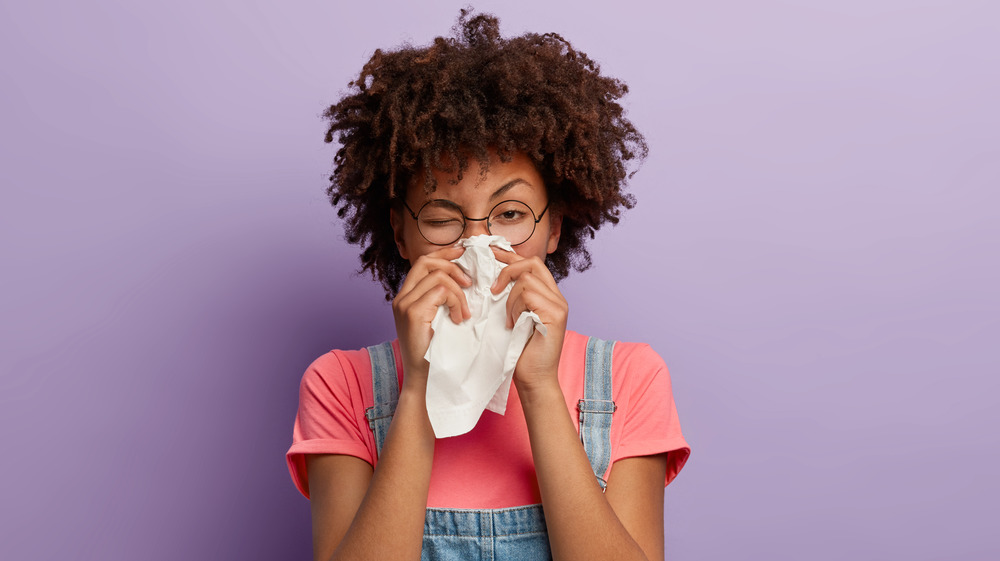Surprising Allergies You Probably Never Even Realized You Had
Allergies are the immune system's response to generally harmless substances. An allergic reaction can range from mild, involving a rash or hives, to a severe and life-threatening response known as anaphylaxis, according to the Cleveland Clinic.
An allergic reaction begins in the immune system. When a substance like dust, mold, or pollen is encountered by someone who is allergic, the immune system overreacts by sending antibodies to fight off the allergen. Symptoms from this response may include wheezing, rash, runny nose, itchy eyes, and other symptoms. According to the Cleveland Clinic, anaphylaxis can start out with severe itching of the eyes or face. It might evolve into a serious reaction and cause additional symptoms like throat swelling, mental confusion, a drop in blood pressure, and dizziness.
Just as there are many ways allergies can affect you, there are many types of allergies. Some are seasonal, such as pollen allergies, and others are year-round, like dust allergies. Some allergies, like food allergies, are lifelong. Pollen and dust are some of the most common allergies, but you can be allergic to other things, too. Read on to find out about surprising things you could just be allergic to.
You could have an allergy to wine
Wine is a popular alcoholic beverage that has been touted to have many health benefits when consumed in moderation. For example, according to a review in the journal Wine Economics and Policy, moderate wine consumption can reduce the risk for heart disease death and heart attack by as much as 30 to 50 percent.
While rare, it is possible to be allergic to wine. According to a review in the German medical journal Allergologie Select, hypersensitivity to alcohol affects about 10 percent of the general population. Possible allergens could be the grapes, proteins or other ingredients used in making wine, or other allergens that make their way into the product, like insects.
Symptoms of a wine allergy can be similar to a food allergy (via American Academy of Allergy, Asthma & Immunology). Symptoms may include a runny nose, congestion, or a burning feeling in the lips, mouth, or throat. Rashes or hives, digestive troubles, and shortness of breath are also possible. If you experience any allergy-like symptoms after drinking wine, you should see a doctor to determine the source of the reaction and to find out if you need treatment.
You could be allergic to water (including your own sweat)
Aquagenic urticaria, also known as a water allergy, is a rare type of physical urticaria (hives) that develops after skin is in contact with water, Healthline explained. While the main symptom of aquagenic urticaria is hives, severe cases may also lead to symptoms like wheezing and problems with breathing and swallowing.
Many types of water sources can cause a reaction, including snow, sweat, and tears, revealed Healthline. Tap water, sea water, and swimming pool water can also trigger a water allergy. Although a reaction from a water allergy usually occurs within a half-hour of exposure and can last up to two hours after the exposure has ended, symptoms of a water allergy usually subside within an hour after you have dried your body, the publication detailed.
Thankfully, aquagenic urticaria is rare and, according to a 2018 report in the dermatology journal Dermatologica Sinica, there have only been about 50 cases reported in the medical literature.
You could have an exercise allergy
Exercise-induced anaphylaxis is rare but can occur during a workout and last for hours (via Merck Manual). It is more likely to occur if you eat certain foods, like wheat or shrimp, prior to exercising. Symptoms of anaphylactic reaction related to exercise include having trouble breathing, decreased blood pressure, dizziness, and fainting.
Exercise can also trigger asthma attacks in people who have allergic asthma, but some people may only experience asthma when they exercise, Merck Manual explained. Exercise triggers asthma because breathing quickly cools and dries out the airways. Once the airways become warm again, they will narrow. With exercise-induced asthma, the chest feels tight and you may experience wheezing, coughing, and difficulty breathing.
If you experience symptoms of exercise-induced anaphylaxis while exercising, stop what you are doing and try to relax. Use a rescue inhaler for an asthma attack and call 911 if symptoms escalate. A severe anaphylaxis attack can cause pale, clammy skin, weak, rapid pulse, breathing problems, confusion, and loss of consciousness, according to Healthline.
You might just be allergic to sunlight
A sun allergy is term describing a number of conditions in which an itchy, red rash appears on the skin after exposure to sunlight. According to the Cleveland Clinic, the most common type of sun allergy is polymorphic light eruption (PMLE). You might be surprised to learn that it affects 10 to 15 percent of the United States population. PMLE is more common in women than men and starts as early as the teen years. Symptoms of PMLE include an itchy rash, blisters, or small reddened areas, and are more frequent during the spring.
Some people have a heredity type of sun allergy, while others develop symptoms of a sun allergy from certain medications or chemicals (from cosmetics or fragrances) applied to the skin and reacting to sunlight. Mild cases of a sun allergy can clear on their own; severe cases are treated with steroid creams or pills.
The best ways to prevent against this allergy is to use sunscreen, wear protective clothing, and avoid sun exposure during the hours of maximum exposure. Of course, this is sage advice even if you don't have a sun allergy.
You can experience an allergic reaction from scratching your skin
Dermatographism is a benign skin reaction that occurs in some people when scratching their skin. It affects up to 5 percent of the population, according to a report in StatPearls, and causes a localized hive-like skin reaction after just light pressure or small trauma is inflicted on the skin. Swelling results just a minutes following the skin trauma. The exact cause of dermatographism is unknown, but researchers think it is caused by an abnormal release of histamine related to an immune system response.
According to the American College of Allergy, Asthma & Immunology, tight clothing and leaning against hard surfaces can also cause an allergic reaction in people with dermatographism. Additionally, a rarer type of dermographism can occur after a bacterial or fungal infection or after treatment with penicillin.
Symptoms of dermatographism usually go away on their own. If they don't go away, though, antihistamines can help to reduce symptoms. Light therapy is used for people who experience frequent episodes of this allergy, and over-the-counter vitamin C is used to reduce histamine and potentially reduce the frequency of episodes of dermatographism.
You might be allergic to jewelry and other metal objects
People who have metal allergies can experience allergic reactions from touching coins, jewelry, and even doorknobs, according to the Cleveland Clinic. This type of reaction is known as allergic dermatitis or contact hypersensitivity. It's relatively common, affecting up to 15 percent of the population, a 2014 report in Immunologic Research explained. According to Dr. John Anthony, a dermatologist with Cleveland Clinic, you can develop an allergy to any kind of metal, but nickel, cobalt, and chromates are the most common.
When a person is allergic to metal, skin cells pick up small molecules from the material and these travel to the lymph nodes, according to the Cleveland Clinic. The body will treat these small molecules as foreign invaders and trigger an overactive immune system response. This can cause mild to severe symptoms that include redness, itching, swelling, rash, blisters or scaling at the affected area. Avoiding the type of metal you're allergic to is a safe bet, as each time you are exposed, the skin will react the same.
You could be allergic to the cold
Although most people in the U.S. hate winter, there are some people who have an especially good reason to dislike the frigid temperatures: they're allergic to the cold. Cold urticaria is a skin reaction that occurs in some people after exposure to cold. Affected skin will develop hives, and cold urticaria can also cause swelling of hands after grasping cold objects and swelling of the lips from consuming cold foods or drinks.
"If someone has a cold allergy, every time they go out in certain temperatures, they'll break out in hives in any of the areas that's exposed to the temperatures," Sandra Hong, an allergist, told the Cleveland Clinic.
A reaction to the cold occurs within five to ten minutes after exposure and can last up to two hours, according to the medical center. Some people with cold urticaria have minor reactions to cold while others might have severe reactions. Severe cases caused by situations like swimming in very cold water can lead to life-threatening symptoms, including fainting, shock, and death. Treatment usually involves preventive measures, such as taking antihistamines and avoiding cold air, cold temperatures, and cold water.
It's possible to be allergic to fruits and vegetables
You might have an excuse to pass on the vegetables and skip right to dessert if you have oral allergy syndrome (OAS), also called pollen fruit syndrome (PFS). This condition affects up to 50 to 70 of people who are allergic to birch tree pollen, according to the American Academy of Allergy, Asthma & Immunology (AAAAI). A reaction to a fruit or vegetable occurs because some proteins in these foods are similar to pollen and confuse your immune system to cause an allergic reaction.
Symptoms of a fruit or vegetable allergy are usually mild and will respond to antihistamines. Symptoms may include redness, mild swelling and itching of the mouth, face, lips, tongue, and throat, according to the AAAAI. A person who is highly allergic to pollen, however, can develop an anaphylaxis reaction. Symptoms can be managed by avoiding foods that cause an allergic reaction, and some people with OAS see symptom improvement with allergy shots.
People with this allergy will often have positive allergy tests for pollen, along with a history of allergic reaction after eating the suspected food or foods. Reactions to OAS are also typically worse during high-pollen seasons.
You could be allergic to meat
If you develop a rash, become nauseated, or develop a stuffy nose after eating meat, you might just have a food allergy, according to the American College of Allergy, Asthma & Immunology (ACAAI). You can have an allergic reaction to any kind of meat, and this allergy has become more prevalent in recent years due to increased recognition.
Meat allergies, especially to beef and pork, are especially common in the United States, according to the ACAAI. They are usually related to alpha-gal, a carbohydrate found in the cell membranes of mammals. Meat allergies are also believed to be caused by Lone Star ticks. If you've been bitten by this kind of tick, you can later develop an allergy to beef and pork.
An allergic reaction to meat can range from mild to severe. Symptoms may include headaches, hives, itching or rash, swelling of the lips, face, tongue, or throat, runny nose and sneezing, digestive troubles, wheezing, or shortness of breath. Your allergist can perform an allergy test to confirm if you have an allergy to certain types of meat.
You can be allergic to your tattoos
People can experience bad reactions immediately after getting a tattoo — and even years later. According to the American Academy of Dermatology (AAD), allergic reactions to tattoo pigment, especially red pigment, can occur. A pigment allergy might cause a rash that is itchy, red, or bumpy. It can be treated with a topical steroid cream, but you should contact your doctor if you experience a serious reaction that includes pain or severe swelling, or if you think you have an infection.
Even temporary tats pose a risk; you could get an allergic reaction from a henna tattoo for up to three weeks after application, according to the AAD. This allergy is caused by reaction to a chemical in black dye. Symptoms of an allergic reaction to henna include redness and swelling, itch, skin pain, blisters, skin discoloration, and scarring in the affected area. In a severe reaction, you might have problems with breathing, a racing heart, chest tightness, dizziness, intense swelling, pain, flushing, or hives.
You might be allergic to your laundry detergent even if you don't have symptoms right away
Laundry detergents and fabric softeners are loaded with strong chemicals, which means it is not uncommon to experience allergies as a result. And according to the Cleveland Clinic, there are two types of reactions associated with these products: irritation and allergic contact dermatitis. Irritation causes a red, itchy rash as soon as you touch the clothing washed with the detergent or fabric softener but irritation stops once you stop using the product. Allergic contact dermatitis, on the other hand, doesn't occur immediately.
A true allergy to a laundry detergent or fabric softener causes symptoms up to a week later. "It can take the immune system a while to identify allergens," pediatric dermatologist Joan Tamburro told the medical center. "You can be exposed to a substance multiple times before having a response."
Contact dermatitis from laundry detergent or fabric softener causes a red, itchy rash. The rash can be widespread or confined to specific areas like the armpits. The allergic response can develop after one exposure or after multiple exposures to the product. You can reduce your risk for a laundry detergent allergy by using products that do not contain fragrances or dyes.
Your nightly chamomile tea could be causing your allergic reaction
Chamomile tea is a widely used herbal tea with a strong, distinctive scent. It has also been used an ingredient in lotions and topical treatments. According to Harvard Women's Health Watch, chamomile teas can help you relax and fall asleep. Long-term use of chamomile is even safe for treating moderate to severe symptoms of generalized anxiety, according a 2015 study reported in the journal, Phytomedicine.
Nevertheless, some individuals can experience mild allergic reactions after drinking the tea, the National Center for Complementary and Integrative Health (NCCIH) explained. Allergic reactions to chamomile tea are usually mild; the mouth, throat, and lips may burn or itch, or you could develop hives. However, more serious reactions can lead to anaphylaxis. "People are more likely to experience allergic reactions to chamomile if they're allergic to related plants such as ragweed, chrysanthemums, marigolds, or daisies," NCCIH stated.













